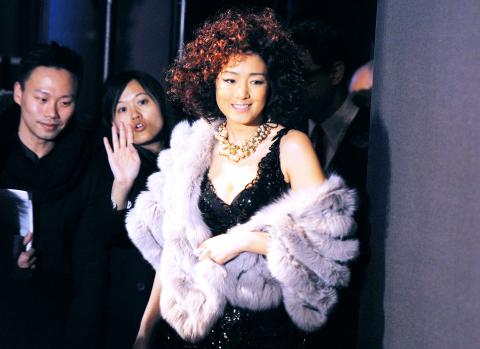Miuccia Prada has already won plaudits for her spring/summer collection for this year — simply-cut dresses and suits in a quirky mix of stripes and solids, with bold splashes of orange, violet and electric blue.
However, by displaying the clothes on a runway in Beijing on Saturday evening, her first catwalk show outside Europe, and adding a few looks from her spring menswear line, the Italian designer signaled her focus on China’s huge market.
Actresses Gong Li (鞏俐) and Maggie Cheung (張曼玉) added a bit of high-wattage star power to the show at the Central Academy of Fine Arts museum — a surefire way to maximize local media coverage and get the Prada message to the masses.

PHOTO: AFP
China is the world’s fastest-growing market for luxury goods and is forecast to be the world’s top buyer of such products — cosmetics, handbags, watches, shoes and clothes — by 2015, according to consultancy PriceWaterhouseCoopers.
Sales of luxury goods in China totaled US$10.3 billion in 2009, up 14 percent from the year before, according to Bain and Co. When purchases by Chinese citizens abroad are factored in, the market was worth US$23.7 billion.
Like many Western fashion brands, Prada is already established in China, with at least 15 stores in operation and plans for nearly 30 more by the end of next year. It has also announced it will open a design studio in Hong Kong this year.
However, luxury goods analysts say foreign firms have only scratched the surface of the market’s vast potential, which is based on the country’s population of 1.3 billion and the mounting wealth of an ever-growing middle class.
“In China, we consider that luxury is still in a pure recruitment phase,” HSBC analyst Erwan Rambourg told reporters, explaining that 90 percent of Chinese buyers are newcomers to a brand, while the rest are repeat customers. “It is still a very underpenetrated market.”
The Milan-based family-owned Prada, which is rumored to be considering a market listing in Hong Kong, was not the first fashion powerhouse to stage a major event in China to lure more customers to the cash register.
Fendi used the Great Wall as a catwalk in 2007, Christian Dior used Shanghai as the backdrop for a show and an ad campaign starring French actress Marion Cotillard and Phillip Lim staged a show at Beijing’s Forbidden City last year.
“China has become a place where not only luxury brands do local brand-building events; China is now front and center in luxury brands’ global marketing campaigns,” said Bruno Lannes, a Shanghai-based partner at Bain.
Chanel, Louis Vuitton and Gucci remain the most desired brands in China, according to Bain, in part because of their iconic logos — which convey status, a key driver for Chinese buyers — but experts say tastes are changing.
In Bain’s research study, Prada, which first unveiled its spring/-summer collection for this year in Milan, Italy, last September, is now the ninth most desired brand.
“Prada stands for good taste and individuality. That shows that Chinese consumers are becoming more sophisticated,” said Zhou Ting (周婷), a professor at the University of International Business and Economics of China.
Other more subtle labels, such as Balenciaga and Balmain, have recently set up shop at a new luxury mall in central Beijing. Lanvin, a brand synonymous with understated elegance, is soon to open its doors in the same complex.
Rambourg said that while some foreign labels adapt their merchandise in China to be more logo-driven in response to consumer demand, this approach is quickly being abandoned.
“I think the fascination of Chinese people for Western brands is that they want the real stuff. That is the aspirational aspect of the product. If you make it too Chinese, they are not going to be interested,” he said.
The influential editor of US Vogue, Anna Wintour, visited Beijing last month, telling local media that she wanted to experience China for herself so she could encourage US labels to boost their presence in the country.
Analysts say foreign brands have yet to even conquer major cities such as Beijing and Shanghai. They can then target the second and third-tier cities in the country’s vast interior — home to tens of millions of savvy shoppers.
“Expansion in tier two and three cities is one of the major strategic directions for all luxury brands, not just the leading ones,” Lannes said.
American designer Diane Von Furstenberg is venturing into China with shops in Beijing and Shanghai and a retrospective featuring her sketches, designs and prints will begin in Beijing’s trendy 798 art district in April.
“I’ve always had this fantasy. I’d like to sell every Chinese a T-shirt,” she told the New York Times last month.

To many, Tatu City on the outskirts of Nairobi looks like a success. The first city entirely built by a private company to be operational in east Africa, with about 25,000 people living and working there, it accounts for about two-thirds of all foreign investment in Kenya. Its low-tax status has attracted more than 100 businesses including Heineken, coffee brand Dormans, and the biggest call-center and cold-chain transport firms in the region. However, to some local politicians, Tatu City has looked more like a target for extortion. A parade of governors have demanded land worth millions of dollars in exchange

An Indonesian animated movie is smashing regional box office records and could be set for wider success as it prepares to open beyond the Southeast Asian archipelago’s silver screens. Jumbo — a film based on the adventures of main character, Don, a large orphaned Indonesian boy facing bullying at school — last month became the highest-grossing Southeast Asian animated film, raking in more than US$8 million. Released at the end of March to coincide with the Eid holidays after the Islamic fasting month of Ramadan, the movie has hit 8 million ticket sales, the third-highest in Indonesian cinema history, Film

Taiwan Semiconductor Manufacturing Co’s (TSMC, 台積電) revenue jumped 48 percent last month, underscoring how electronics firms scrambled to acquire essential components before global tariffs took effect. The main chipmaker for Apple Inc and Nvidia Corp reported monthly sales of NT$349.6 billion (US$11.6 billion). That compares with the average analysts’ estimate for a 38 percent rise in second-quarter revenue. US President Donald Trump’s trade war is prompting economists to retool GDP forecasts worldwide, casting doubt over the outlook for everything from iPhone demand to computing and datacenter construction. However, TSMC — a barometer for global tech spending given its central role in the

Alchip Technologies Ltd (世芯), an application-specific integrated circuit (ASIC) designer specializing in server chips, expects revenue to decline this year due to sagging demand for 5-nanometer artificial intelligence (AI) chips from a North America-based major customer, a company executive said yesterday. That would be the first contraction in revenue for Alchip as it has been enjoying strong revenue growth over the past few years, benefiting from cloud-service providers’ moves to reduce dependence on Nvidia Corp’s expensive AI chips by building their own AI accelerator by outsourcing chip design. The 5-nanometer chip was supposed to be a new growth engine as the lifecycle